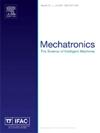基于约束空间路径的机器人姿态控制框架及其实现
IF 3.1
3区 计算机科学
Q2 AUTOMATION & CONTROL SYSTEMS
引用次数: 0
摘要
本文提出了一种新的机器人姿态控制框架,用于机器人以等速穿越给定的空间曲线。该框架的关键是使用旋转最小化框架(RMF)进行路径生成和控制,增强具有显著曲率和拐点的路径的运动稳定性,并减少运动学扭曲。利用基于RMF的控制方程,首先推导出与RMF一致的参考速度和参考加速度。利用微分几何工具,通过将机器人的平移状态投影到RMF上,推导出路径跟随位置控制律。从相对姿态误差运动学的分析描述出发,利用修正罗德里格斯参数推导出一种稳定姿态控制器,以避免解卷问题。所提出的框架适用于转矩控制和速度控制的机器人,并提供了两种类型机器人的实时实验结果,以验证所提出方法的有效性和优势。本文章由计算机程序翻译,如有差异,请以英文原文为准。
A novel pose control framework and its implementation for robot manipulators following constrained spatial paths
This paper develops a novel pose control framework for robot manipulators traversing a given spatial curve with constant speed. The key to this framework is the use of a Rotation Minimizing Frame (RMF) for path generation and control, enhancing motion stability for paths with significant curvature and inflection points, and reducing kinematic twist. Using the governing equations based on the RMF, we first develop the reference velocity and acceleration along the path that is consistent with the RMF. Employing tools from differential geometry, we derive a path following position control law by projecting the robot translation states onto the RMF. From an analytical description of the relative orientation error kinematics, we derive a stabilizing orientation controller by utilizing the Modified Rodrigues Parameters to avoid the unwinding problem. The proposed framework is applicable to both torque-controlled and velocity-controlled robots, and we provide results from real-time experiments on both types of robots to verify the effectiveness and advantages of the proposed approach.
求助全文
通过发布文献求助,成功后即可免费获取论文全文。
去求助
来源期刊

Mechatronics
工程技术-工程:电子与电气
CiteScore
5.90
自引率
9.10%
发文量
0
审稿时长
109 days
期刊介绍:
Mechatronics is the synergistic combination of precision mechanical engineering, electronic control and systems thinking in the design of products and manufacturing processes. It relates to the design of systems, devices and products aimed at achieving an optimal balance between basic mechanical structure and its overall control. The purpose of this journal is to provide rapid publication of topical papers featuring practical developments in mechatronics. It will cover a wide range of application areas including consumer product design, instrumentation, manufacturing methods, computer integration and process and device control, and will attract a readership from across the industrial and academic research spectrum. Particular importance will be attached to aspects of innovation in mechatronics design philosophy which illustrate the benefits obtainable by an a priori integration of functionality with embedded microprocessor control. A major item will be the design of machines, devices and systems possessing a degree of computer based intelligence. The journal seeks to publish research progress in this field with an emphasis on the applied rather than the theoretical. It will also serve the dual role of bringing greater recognition to this important area of engineering.
 求助内容:
求助内容: 应助结果提醒方式:
应助结果提醒方式:


